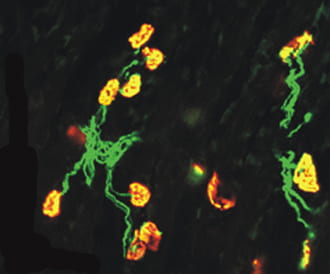The basic principles governing communication between the cells of the nervous system are determined by intrinsic molecular constituents and the environments in which cells reside. The molecular components include neuron-specific assembly of cell-surface receptors, ion channels, transporters, neurotransmitters and neuromodulators, and intracellular second messenger signaling proteins and transcriptional regulators. The mechanisms by which these specific molecules regulate a diverse array of cellular processes are being actively investigated, including: contributions of genetic and epigenetic factors; modes of excitability in axons versus dendrites; synaptogenesis and synaptic communication and plasticity; the ability of axons to establish topographic functional connections; and sensory processing and signal transduction in auditory, olfactory, taste, visual and tactile systems. Our training faculty members accomplish their research goals using a wide range of methods to identify and manipulate the molecular components of cells. These approaches include the use of next gen sequencing methods and microarrays to screen for genes of interest, real time and fixed high resolution in vitro and in vivo cellular imaging, and electrophysiological recordings using optogenetic and single cell approaches to determine functional properties of neurons, and the cell autonomous and non-autonomous factors that influence their functions.

One specific area of focus is on sensory systems, where USC researchers have made major contributions to our understanding of the signaling pathways that underlie hearing, vision, taste, pheromones, and somatosensation. Another area in which USC researchers continue to make important scientific contributions is in the mechanisms of trafficking, regulation and function of ion channels, receptors, and transporters. Because a diverse array of proteins determine the electrical excitability of both peripheral and central neurons, understanding these processes has implications for the treatment of psychiatric, neuromuscular, and degenerative disorders of the nervous system. The study of synaptic communication and regulated secretion are other areas of strength at USC. Researchers have made key discoveries in the ways in which synaptic transmission is altered during development, learning, aging, and in response to hormones or drugs of abuse, as well as in the fundamental mechanisms of secretion. Finally, an important area of research in cell and molecular neuroscience in the NGP is focused on identifying genes that comprise the molecular basis for complex behaviors, such as courtship in the fly, ingestive and sensory behaviors and social communication and emotional regulation in mammals.
Robust interactions among NGP neuroscientists working at the cellular and molecular level are enhanced by weekly journal clubs, interest groups and a number of external speakers in various seminar series sponsored by the NGP and other departments and institutes at USC. Research in cell and molecular neuroscience is supported by a number of core facilities for cellular imaging, transgenic mouse production, epigenomics and next gen RNA and DNA sequencing. Molecular neuroscientists further benefit from collaborations with colleagues in computational and molecular biology, who excel at analyzing large and complex data sets.
Faculty Members
Don Arnold
Karen T Chang
Jeannie Chen
Robert Hsiu-Ping Chow
Cheryl Mae Craft
Gage Crump
Dion Kai Dickman
Caleb E. Finch
Judith A. Hirsch
Chien-Ping Ko
Pat Levitt
Emily R. Liman
David D. McKemy
Christian J. Pike
Neil Segil
Jean C. Shih
Derek Sieburth
Huizhong W. Tao
Li I Zhang